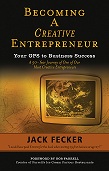March 18, 2010
Becoming a Creative Entrepreneur
Your GPS to Business Success
Jack Fecker
Aviva Publishing (2009)
ISBN: 9780984149766
Creative Entrepreneurial Book Provides Gold Nuggets for Successful Future
What is the secret to Jack Fecker’s success? It’s definitely creativity—thinking outside of the box and envisioning what you want—along with not being afraid to go after your dreams. Throughout “Becoming a Creative Entrepreneur,” Jack provides innovative yet practical methods for taking your business to the next level, whatever that business might be. The important thing is to enjoy what you do, believe what you want is possible, and keep the spiritual element in your work. Jack reminds us of Samuel Goldwyn’s advice, one of many priceless sayings in the book, “No person who is enthusiastic about his work has anything to fear from life.”
Whatever you want in life, whether it’s to own your own business, find the perfect mate, or simply live a happier, fuller life, Jack Fecker’s book offers a GPS for how to get there. One of my favorite sections described the importance of treasure mapping to envision what you want. Treasure mapping is the concept where with pictures, words, and symbols you create a visual of what you desire as your end result. As a perfect example, Jack tells how he met his wife, Jane in 1982, and how impressed he was that she was using this process, a sign to him that she just might be the right soul mate for him. After they had dated more than a year, Jane showed him one of her treasure maps, the “marriage one,” complete with phrases like “spontaneous, adventurous, committed, life-long,” etc. and there on top in bold letters were the words “Jack…or Better!” Needless to say, Jane’s vision came to pass. Aside from the fact that Jack realized he’d best not let this one get away, Jack notes he believes this outcome was also due to Jane using one of the key elements necessary for effective treasure mapping—releasing the process (in this case, focusing on the quality of the marriage vs. a specific person), thereby allowing the end result desired to easily become a tangible reality.
Several other unusual and original processes are offered in the book including creating a “storyboard”—a one glance visual of the process or steps to achieve a goal, and also how to achieve a goal by setting a date, or better yet, asking for something FWP (Fastest Way Possible). Jack also explains the effectiveness of realizing, as quantum physics has proven to be true, that what we want in the future has already happened in the present. This idea relieves a lot of stress based on wanting and replaces it with pleasure in envisioning already having what you want. Jack describes his own success from using this process:
I began learning that to create anything I wanted required that I picture it already in existence: What does it look like, feel like, smell like, and what would be my emotions if I had it in present time. Of course, time always enters into the equation, but it became much more powerful to practice the latter, and once I shifted, I began experiencing results immediately.
For more practical people—although they should try some of these more innovative techniques in their businesses—Jack’s experience, advice, and the story of how he successfully built several different businesses will make reading this book time well spent. Jack provides great tips for interviewing to find the right employee. He gives advice on how to make your employees enthusiastic about their jobs, how to get rid of employees who are holding back your business, and whether or not to choose a business partner.
Jack also reminds us not to forget the human, individual or spiritual element in business. He asks us what we want our tombstones to read, and to consider how we want to celebrate our 100th birthday party, along with who will attend it. What I found most interesting were Jack’s theories, based on his half-century of experience, on the future of business. He notes how old systems are crumbling, and as a result, in this modern age of technology, where we can accomplish things faster than in the past, he tells us it is time to be creative. He provides a great list of elements needed for the businesses of the future to succeed. These ideas about honesty, integrity, the difference between a boss and a leader, and how to incorporate storytelling and fellowship among the employees to provide that human and spiritual element to business, not to mention many more, are alone worth the price of the book.
“Becoming a Creative Entrepreneur” fully lives up to its title. It is time that our notion of business, which has become cold, corporate, and corrupt, be replaced with a belief that work is fun and that businesses are places where enthusiasm thrives, customers and employees are valued as individuals, and creativity provides self-esteem to employees. Jack Fecker is both a prophet for the future of business, and an invaluable mentor for how to bring about that future.
For more information on “Becoming a Creative Entrepreneur,” visit www.BecomingACreativeEntrepreneur.com
— Tyler R. Tichelaar, Ph.D. and author of the award-winning Narrow Lives


